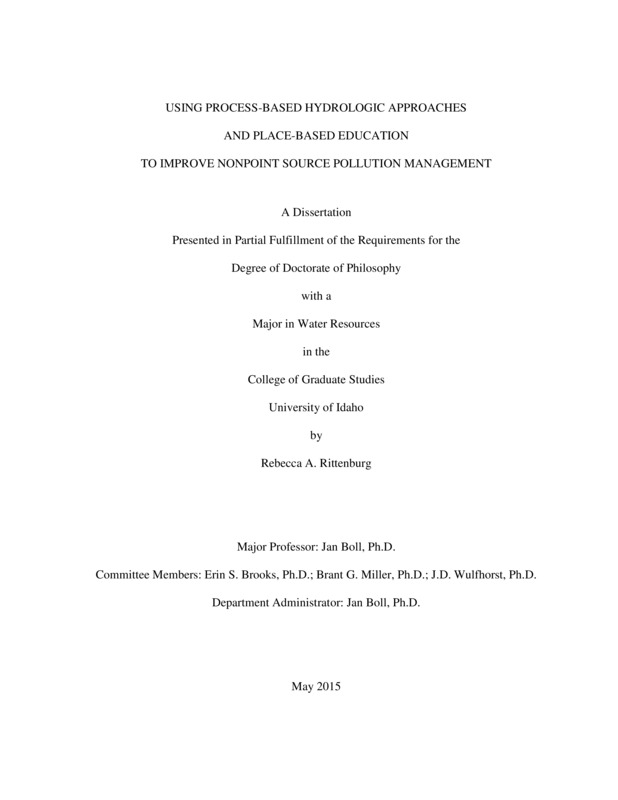USING PROCESS-BASED HYDROLOGIC APPROACHES AND PLACE-BASED EDUCATION TO IMPROVE NONPOINT SOURCE POLLUTION MANAGEMENT
Rittenburg, Rebecca. (2015). USING PROCESS-BASED HYDROLOGIC APPROACHES AND PLACE-BASED EDUCATION TO IMPROVE NONPOINT SOURCE POLLUTION MANAGEMENT. Theses and Dissertations Collection, University of Idaho Library Digital Collections. https://www.lib.uidaho.edu/digital/etd/items/rittenburg_idaho_0089e_10424.html
- Title:
- USING PROCESS-BASED HYDROLOGIC APPROACHES AND PLACE-BASED EDUCATION TO IMPROVE NONPOINT SOURCE POLLUTION MANAGEMENT
- Author:
- Rittenburg, Rebecca
- Date:
- 2015
- Embargo Remove Date:
- 2015-11-18
- Keywords:
- agriculture best management practices hydrologic modeling nonpoint source pollution place based education watershed hydrology
- Program:
- Water Resources
- Subject Category:
- Water resources management; Environmental education; Hydrologic sciences
- Abstract:
-
Despite widespread investment in watershed conservation and outreach efforts to improve water quality in agricultural watersheds through best management practices (BMPs), agricultural nonpoint source (NPS) pollution remains a leading cause of water impairment in the U.S. I theorize the disconnect between conservation efforts and apparent lack of water quality improvements is more accurately a delayed and dynamic feedback from both the ineffective placement of BMPs, physical lag time inherent in the response of water bodies to BMPs, and the social lag time associated with community participation in conservation. The objectives of this research are to advance understanding and develop hydrological and outreach tools to measure and accelerate conservation effectiveness. Chapter 2 is a review paper, which presents a conceptual framework to recommend optimal BMPs that target a watershed’s dominant pollutant flow paths to improve conservation effectiveness. Using data in a disturbed, mixed land use watershed with cohesive sediments, Chapter 3 validates the pairing of a hillslope hydrology and erosion model and a fluvial sediment transport model to evaluate spatiotemporal impacts of BMPs on sediment storage and transport in the stream system, and Chapter 4 assesses overall trends in sediment dynamics in the stream system, validating a region-specific channel evolution model to track stream channel recovery from disturbances. These two chapters advance current understanding on how cohesive fluvial systems impact the physical lag time of watershed response to BMPs. Chapter 5 proposes a link between K-12 outreach efforts and increasing BMP implementation through a qualitative inquiry of the effects of youth capital and a place-based learning watershed conservation outreach program on landowner BMP adoption behavior. Investments in youth capital increased interactions between students and community, mobilized conservation resources, and established trusted relationships between landowners and community conservationists to implement BMPs. Chapter 6 concludes by developing a standards-aligned curriculum blueprint for implementing place-based watershed outreach to engage students and community in conservation. This collection of papers provides recommendations to measure and accelerate BMP effectiveness, and provides evidence that K-12 outreach programs can play a role as community catalysts to increase BMP adoption behavior, thus reducing the social lag time in conservation participation.
- Description:
- doctoral, Ph.D., Water Resources -- University of Idaho - College of Graduate Studies, 2015
- Major Professor:
- Boll, Jan
- Committee:
- Brooks, Erin S; Wulfhorst, J.D.; Miller, Brant G
- Defense Date:
- 2015
- Identifier:
- Rittenburg_idaho_0089E_10424
- Type:
- Text
- Format Original:
- Format:
- application/pdf
- Rights:
- In Copyright - Educational Use Permitted. For more information, please contact University of Idaho Library Special Collections and Archives Department at libspec@uidaho.edu.
- Standardized Rights:
- http://rightsstatements.org/vocab/InC-EDU/1.0/

